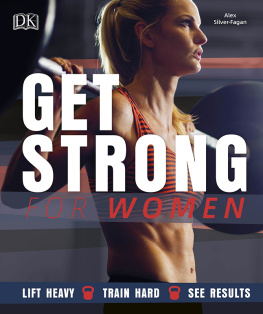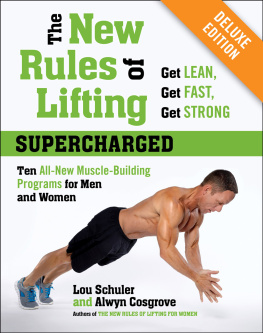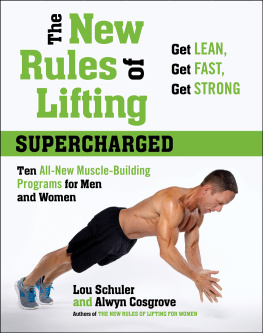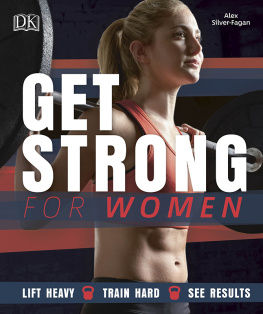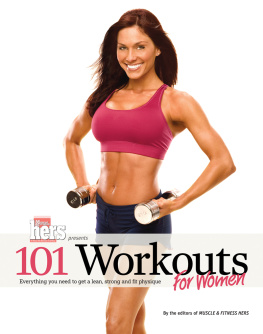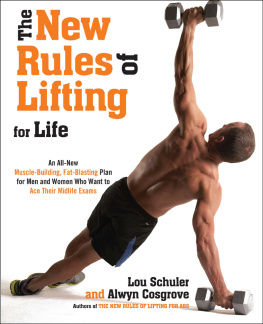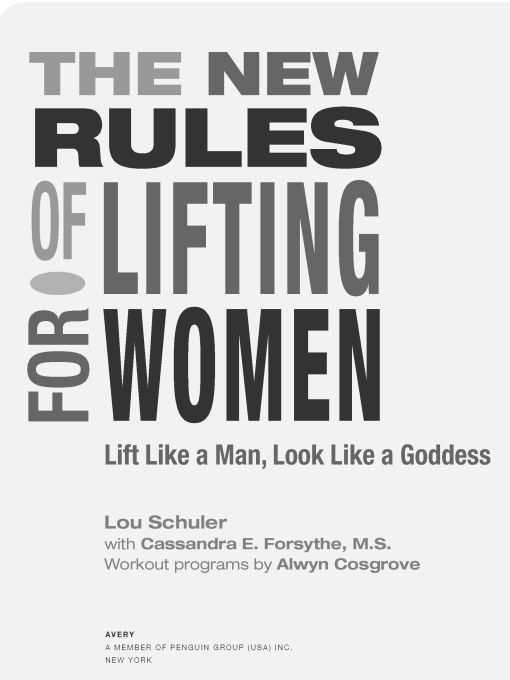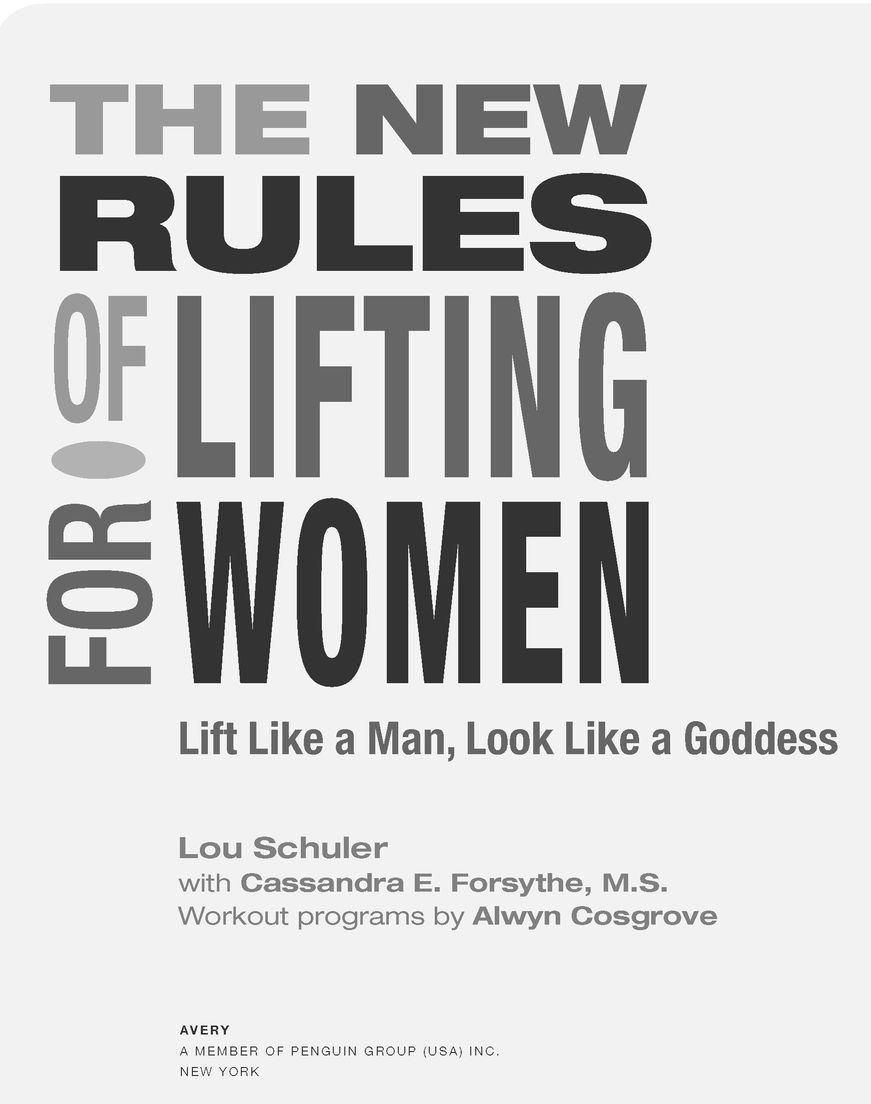Table of Contents
Acknowledgments
THIS BOOK EXISTS for one reason. After the original New Rules of Lifting was published in January 2006, I received countless e-mails from women asking me why Id written it for men and ignored their gender entirely. I gave the same reply to many of them: It had never occurred to me to write for any other audience. Id been fitness editor at Mens Fitness and Mens Health magazines. My first book was called The Testosterone Advantage Plan. I assumed the audience for New Rules would be the same one Id been addressing since 1992.
So for starters, I want to thank the many women who persuaded me to write a book for them.
Second, I want to thank my editor, Megan Newman, a longtime lifter who immediately saw the potential of The New Rules of Lifting for Women. Megan went all out to make the book much better than it wouldve been in the hands of any other editor.
Neither New Rules book would have been possible without Alwyn Cosgrove, who designed the workout programs and who has opened my eyes to more great ideas about strength training than anyone else Ive worked with.
The new kid on this project is Cassandra Forsythe, whom Id met only once, several years ago, but who enthusiastically jumped aboard when I sent her an e-mail out of the blue to see if shed be interested in working on this project. Cassandra, a scientist as well as a lifter, inspired and informed this book from beginning to end, and even persuaded her friend Michelle Bower, a strength coach and athlete in Connecticut, to journey to Allentown to act as our model.
Three other contributors made this book possible, as well as a joy to create: my agent, David Black; publicist Gregg Stebben, who more than anyone else is responsible for womens finding out about the original New Rules of Lifting; and photographer Michael Tedesco, a longtime colleague whose talent and efficiency made our two-day photo shoot the least stressful of my career.
Thanks also to John Schuler, our illustrator; Mike Mejia, who introduced me to Alwyn; John Berardi, who introduced me to Cassandra; Rebecca Behan at Avery; John Graham and Mike Cerimele at Velocity Sports Performance in Allentown; Mark Verstegen and Amy Wilson at Athletes Performance; Adam Campbell; and Pete Williams.
I dedicate this book to all the strong women in my life: my mom, Dorothy Schuler, who had biceps before biceps were cool on women; my wife, Kimberly Heinrichs; our younger daughter, Annelise, the familys ballerina; and our older daughter, Meredithsoccer player, skater, climber, and future lifter.L.S.
I first want to thank Lou for bringing me in to work on a book that so completely reflects my personal views on diet and exercise. I also want to thank Justin Pribanic, my soul mate, my best friend, and the one man who understands why I work as hard as I do. Im looking forward to sharing the rest of my life with you.
Thanks to Jeff Volek, my Ph.D. supervisor at the University of Connecticut and the best mentor I could ever hope for.
Finally, I thank my family for loving me and believing in me. This book is for you.
C.E.F.
Thank you to Derek Campbell, my coach, mentor, and friend. To all the athletes and clients who have trusted me with their bodies, thank you for believing in me. To my friends, colleagues, and teammates over the years, thank you for pushing me to new levels. To the team at Results Fitness, thank you for allowing me to test my theories on you. Thanks to my dad and to my wife, Rachel. And thanks to my mum, who never got the chance to see the lessons she instilled in me take root and bear fruit. This book is for you.A.C.
Introduction: The Man Show
THE FIRST THING youll notice about this book is that its a diet and workout guide for women, written by someone who isnt a woman. In my career as a nonwoman, Ive written at least four books for men. (I say at least because the concept of authorship can get fuzzy in this genre.) Ive been fitness editor at Mens Fitness magazine and fitness director at Mens Health, and when I wasnt writing for either of those magazines I did some articles for Mens Journal. I write a weblog called Male Pattern Fitness, on which I write primarily about health and fitness issues affecting men.
And yet every time I explain the premise of this book to a woman, the reaction is something like this: Oh, hell yeah! Or: About damned time! Or: How long do I have to wait?
Those responses have nothing to do with my charm or good looksI can produce sworn statements attesting to my deficiencies in both areasand everything to do with the quality of information about strength training specifically targeted to women.
At a certain point, just about every woman whos ever picked up a dumbbell or walked into a gym reaches the same conclusion: Im doing what Im supposed to be doing, and it isnt working.
The reason:
What youve been told to do isnt what youre supposed to do. In the quarter-century since the idea that women could benefit from strength training kicked in, a powerfully counterproductive notion rose in tandem. Thats the idea that women should use exercises and techniques different from those used by men.
Its a ridiculous premise, bordering on fraudulence.
And yet every time I walk into a weight room, I see women doing things that nobody would ever recommend to her if she happened to be male. Ill grant you that guys do odd and useless things in the gym as well. (And Ill concede that I take some comfort in that; if they all knew what they were doing, Id have to find another way to make a living.) Invariably, these women do not appear to be getting the results they should expect from strength training.
Conversely, when I see a woman doing the exercises and using the techniques my coauthors and I recommend, I can see the difference these methods produce in her posture, her confidence in the gym, and the intensity shes able to generate in her workouts. And thats aside from whatever her physique may look like, or how strong she may be. Shes probably better than average in both categories, but that doesnt matter. Chances are, she was in a position to learn these exercises and techniques because she was already fit and athletic, with a propensity to gain strength fast.
My point is this: Every woman with a genuine interest in strength trainingand here I include anybody who belongs to a gym and uses the weights regularly, or who works out with weights at homeshould know how to do the exercises that will help her reach her goals as quickly and efficiently as possible. She should know how to work out in the most productive ways. And she should know these things regardless of her age, physique, or athletic status.
I hope that this book changes your mind about strength exercise in three different ways:
Youll realize that men and women should be doing workouts that are more similar than different, with women focusing more than they currently do on making their muscles bigger and stronger.
Youll understand that bigger and stronger muscles will look different on you than they do on me, or anyone else in the nonwoman category.
Youll see the importance of variety in your workouts, and appreciate the adage that the best workout for you is the one you havent yet done.


